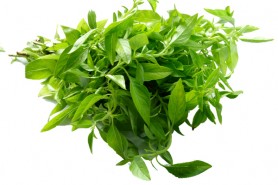Tastes Like Home
I’m in love with Basil – the herb not the man.

The aroma draws you in; you sniff and take deep breaths as your senses are beguiled by the bouquet. Is it clove, is it anise, is it lemon, or is it… There are forty known varieties of ocimum basilium, also called sweet basil. In Guyana, it is known as ‘married-man-pork.’ Don’t ask, I have no idea how that name came about but if you know, do tell.
The word ‘basil’ comes from the Greek basilikon (‘royal’) and the ancient Greeks called basil, ‘the royal herb.’ It is a member of the mint family and is grown all year round in tropical climates such as ours. It is believed that this fragrant herb was probably first cultivated in India and introduced in ancient times to Africa and the Mediterranean through the spice routes.
The most common varieties we have in the Caribbean are the sweet basil, easily recognized for its clove-like scent, the anise basil and lemon basil. The names used to describe each of these basils are associated with its scent.
The clove-scented sweet basil is the popular variety we get here, and is easily recognized by its broad, shiny, deep green-coloured leaves. It is usually sold with and without the stems, and is picked in clusters of four leaves.

Lemon basil is as common as its clove-scented sibling; its leaves are very small, light green in colour and grow more abundantly, almost shrub-like. This variety is more widely sold in Guyana. Another variety that’s found in some home gardens is the anise sweet basil, also known as Thai basil. The leaves are slender and shapely, green in colour but not as shiny as the broad-leafed sweet basil. Be on the lookout for it as I’m sure you’ve seen it, though it is not widely sown. You will recognize it from its purple stalks and lilac-coloured flowers when mature. Then there’s the purple basil that’s popular here now; while the colour is intensely beautiful, the flavour and aroma are mild in comparison with other varieties.
When buying basil, look for bright green, clean leaves; there should be no sign of wilting or dark spots. To store, wrap them loosely in paper towels, place in a plastic bag and refrigerate for up to a week. If you purchase them already packaged, take them out and dry them before wrapping and refrigerating.
Sweet basil is excellent; it brightens a dish with flavour and makes simples dishes extraordinary. It’s great with a variety of things such as broccoli, eggplant, spinach, lamb, chicken, eggs, rice, pasta, salads. The next time you’re going to cook, try it. Chop up the leaves, tear them or add them whole to your dishes just as they are about to finish cooking. Do not chop or tear the leaves long in advance as they will turn dark. Basil loses much of its flavour in long-cooking dishes, so be sure to add it towards the end – or if you have to add it early in the dish, be sure to reserve some to add at the end to brighten and heighten the flavour. Some people even recommend basil for digestive problems. Instead of an after-dinner mint, they suggest sipping a cup of basil tea to aid digestion.
Basil is one of those herbs that can be used in both sweet and savoury dishes. For example, basil is used to flavour ice cream, sorbets and lemonades. Try it, the next time you make some lemonade or swank, as we say in Guyana; bruise a few basil leaves in the jug and stir.
Basil’s a key ingredient in Mediterranean dishes, frequently combined with tomatoes, Thai-like Pad-Kee-Mow (pan fried noodles in spicy basil sauce) and Italian dishes, such as the popular pesto.
Pesto is an Italian sauce used for pastas, grilled meats, poultry and fish. It is also used as a seasoning. Pesto is made from fresh basil, garlic, olive oil and parmesan cheese (pine nuts or walnuts are an option). Some versions also add parsley and mint. The ingredients are ground into a paste and moistened with olive oil. You can make it using a traditional mortar and pestle or a food processor.
For a quick meal, cook your favourite pasta and it toss with pesto sauce. Grill some fish, chicken or meat and serve with heaped teaspoons of pesto. It makes a delectable snack on toasted baguette; your steamed vegetables will never be the same again once you have them with some pesto. I even use my pesto as a salad dressing.
In Guyana, basil is the key herb-flavour when it comes to black pudding. It is also
widely used to make green seasoning; people like to put a few leaves in cook-up rice as well.
Pesto
2 cups fresh basil
2 cloves of garlic
(crushed)
2/3 cup of olive oil
½ cup parmesan cheese
¼ cup pine nuts or walnuts
(optional)
Salt and pepper to taste
In a food processor, combine the basil, garlic, nuts and cheese, pulse until coarsely chopped. With the processor still running, slowly add the olive oil until smooth and fully incorporated. Add salt and pepper to taste and pulse a few times to incorporate. Transfer to a serving bowl.
If you are not going to be using the pesto immediately, store it in an air-tight container; ensure that there’s a thin coating of oil on top to avoid discolouration. It can be stored in the fridge for two weeks or more.
By the way, the word pesto is also used to describe similar sauces that contain other herbs or nuts. You can make a mixed herb pesto, sage pesto, arugula pesto, sun-dried tomato pesto, etc. Enjoy.
Cynthia
tasteslikehome@gmail.com
www.tastesliekhome.org









